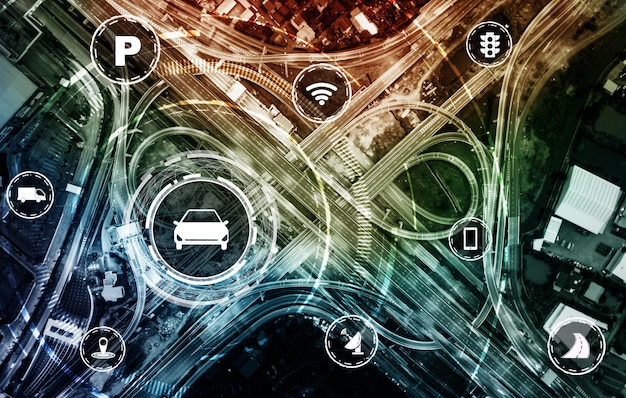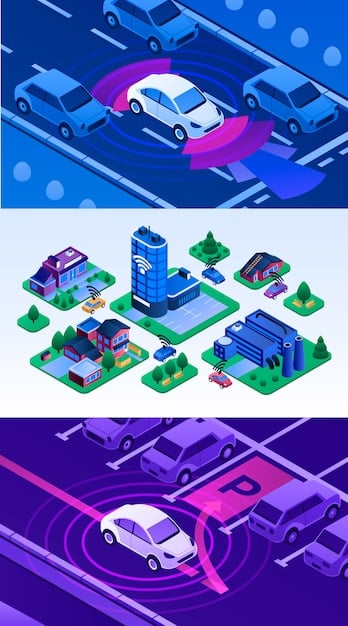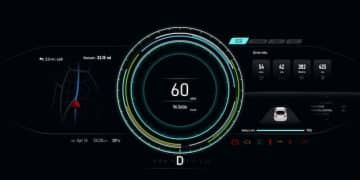Connected Vehicle Security: Navigating New Federal Regulations for US Fleets

Connected vehicle security is being reshaped by new federal regulations in the US, impacting how fleets manage data protection, cybersecurity, and overall operational safety.
The landscape of connected vehicles is rapidly evolving, bringing unprecedented opportunities for efficiency and innovation to US fleets. However, this increased connectivity also introduces significant security vulnerabilities. Recent federal regulations are designed to address these concerns head-on, mandating specific measures to protect data and ensure the safe operation of connected vehicle security. But what exactly do these regulations entail, and how will they affect your fleet?
Understanding the Rise of Connected Vehicle Threats
Connected vehicles represent a significant step forward in transportation technology, offering real-time data, enhanced navigation, and improved fleet management capabilities. However, these benefits come with inherent cybersecurity risks. Understanding these risks is crucial for US fleets to proactively protect their assets and data.
Common Cybersecurity Threats to Connected Vehicles
Connected vehicles are vulnerable to a range of cyberattacks, each posing unique challenges to fleet security. Understanding these threats is the first step in developing effective countermeasures.
- Data Breaches: Hackers can exploit vulnerabilities to access sensitive data such as location history, driver information, and vehicle diagnostics.
- Malware Infections: Connected vehicles can be infected with malware that disrupts vehicle functions, compromises data security, or even grants unauthorized access to vehicle systems.
- Remote Control Attacks: Hackers could potentially gain remote control of vehicle functions, such as steering, braking, or acceleration, creating a serious safety hazard.
- Denial-of-Service (DoS) Attacks: These attacks can overwhelm vehicle systems with data overload, disrupting operations and potentially rendering vehicles unusable.
The Growing Impact of Vehicle Hacking on Fleets
The consequences of successful vehicle hacking can be severe, ranging from financial losses to reputational damage and even physical harm. For US fleets, the stakes are particularly high.

Vehicle hacking incidents can lead to:
- Financial Losses: Due to theft of assets, downtime, reputational damage, or legal liabilities.
- Operational Disruptions: Vehicle hacking can disrupt delivery schedules, compromise logistics, and negatively impact overall fleet efficiency.
- Safety Risks: As mentioned earlier, remote control attacks can compromise driver safety and create serious accidents.
In conclusion, the increasing sophistication and frequency of cyberattacks targeting connected vehicles pose a significant threat to US fleets. A proactive and comprehensive approach to connected vehicle security is essential to mitigating these risks and ensuring the safe and efficient operation of fleet vehicles.
Overview of New Federal Regulations for Connected Vehicle Security
In response to the escalating cybersecurity threats facing connected vehicles, the US federal government has introduced new regulations aimed at strengthening vehicle security standards. These regulations are designed to protect data privacy, prevent unauthorized access to vehicle systems, and ensure the overall safety and security of connected vehicles operating in the US.
Key Provisions of the New Regulations
These regulations focus on several key areas critical to connected vehicle security.
Several key components of the new regulations include:
- Data Security Standards: Mandatory requirements for protecting sensitive vehicle and driver data from unauthorized access and breaches.
- Cybersecurity Protocols: Established protocols for identifying, preventing, and responding to cyberattacks targeting connected vehicle systems.
- Hardware and Software Security Requirements: Minimum security standards for vehicle hardware and software components designed to prevent vulnerabilities and exploits.
Impact on US Fleets
These new regulations have significant implications for US fleets utilizing connected vehicles. Here’s what fleets need to understand.
US fleets should be aware of:
- Increased Compliance Costs: Implementing new security measures and complying with regulatory requirements may entail additional costs for fleets.
- Enhanced Security Measures: Fleets must invest in robust security solutions, such as intrusion detection systems, firewalls, and data encryption technologies, to protect their connected vehicles from cyber threats.
- Data Privacy Implications: Fleets must ensure compliance with data privacy regulations, such as GDPR and CCPA, when collecting and processing data from connected vehicles.
In conclusion, new federal regulations for connected vehicle security represent a crucial step towards protecting US fleets from emerging cyber threats. By understanding the key provisions of these regulations and taking proactive measures to comply with them, fleets can enhance their security posture and minimize the risks associated with connected vehicle technology.
Developing a Comprehensive Connected Vehicle Security Plan
In light of the increasing cyber threats and new federal regulations, US fleets must develop a strong security strategy. A comprehensive plan should incorporate various security measures across all aspects of the vehicle ecosystem.
Risk Assessment and Vulnerability Scanning
The initial step in creating a comprehensive connected vehicle security plan involves performing a thorough risk assessment and vulnerability scanning to identify potential weaknesses in fleet systems. This includes:
- Identifying Critical Assets: Determining which vehicle systems, data, and infrastructure are most critical to fleet operations.
- Assessing Threat Landscape: Understanding the latest cyber threats and attack vectors that could target connected vehicles.
- Vulnerability Scanning: Conducting regular scans of vehicle software, hardware, and network connections to identify potential vulnerabilities.
Implementing Security Measures for Fleets
Once vulnerabilities have been identified, fleets should implement robust security measures to mitigate risks. These measures may include:

- Intrusion Detection and Prevention Systems: Deploying systems that can detect and block malicious activity targeting connected vehicles.
- Firewalls and Network Segmentation: Isolating critical vehicle systems from external networks to prevent unauthorized access.
- Data Encryption and Access Control: Encrypting sensitive data and implementing strict access control policies to protect data privacy.
- Software Updates and Patch Management: Regularly updating vehicle software with security patches to address known vulnerabilities.
Training and Awareness Programs for Fleet Personnel
A critical component of any connected vehicle security plan is training and awareness, to equip fleet personnel with the knowledge and skills necessary to identify and respond to cyber threats. This can be achieved through:
- Cybersecurity Training for Drivers: Training drivers to recognize phishing scams, malware attacks, and other cyber threats that could compromise vehicle security.
- Awareness Campaigns for Fleet Managers: Conducting awareness campaigns to educate fleet managers about the latest cybersecurity risks and best practices for protecting connected vehicles.
Overall, developing a comprehensive connected vehicle security plan requires a multifaceted approach that encompasses risk assessment, implementation of security measures, and training and awareness programs for fleet personnel. By taking these steps, US fleets can strengthen their security posture and minimize the risks associated with connected vehicle technology.
The Role of Technology in Enhancing Connected Vehicle Security
Technology plays a pivotal role in enhancing security, providing tools and solutions to protect against cyber threats. By leveraging advanced technologies, fleets can bolster their defenses and minimize the risks associated with connected vehicle technology.
Intrusion Detection Systems (IDS) for Fleets
IDS are essential tools for detecting and responding to cyberattacks on connected vehicles. These systems monitor network traffic and system behavior for suspicious activity, alerting security personnel to potential threats.
Benefits of IDS
Key benefits of IDS:
- Real-Time Threat Detection: IDS can detect cyberattacks in real-time, enabling rapid response and containment.
- Behavioral Analysis: IDS can analyze vehicle system behavior to identify anomalies that may indicate a cyberattack.
- Automated Response: Some IDS incorporate automated response capabilities, such as blocking malicious traffic or isolating infected systems.
Data Encryption and Authentication Technologies
Data encryption and authentication technologies are critical for protecting sensitive data transmitted by connected vehicles. These technologies ensure that data remains confidential and cannot be accessed by unauthorized parties.
Cybersecurity Standards
These standards offer a structured approach to cybersecurity, helping fleets align with industry best practices and regulatory requirements.
- NIST Cybersecurity Framework: Provides a comprehensive framework for managing cybersecurity risks across the organization.
- ISO 27001: Specifies requirements for establishing, implementing, maintaining, and continuously improving an information security management system (ISMS).
In summary, technology plays a critical role in securing connected vehicles. By leveraging advanced technologies, US fleets can strengthen their security posture, mitigate risks, and ensure the safe and efficient operation of their fleets.
Practical Steps for US Fleets to Comply with Regulations
To successfully comply with new federal regulations, US fleets need to implement specific practical steps. These steps will help fleets align their operations with regulatory requirements and strengthen their security posture.
Conduct a Compliance Audit
The first step is to conduct a thorough compliance audit to assess the fleet’s current security practices and identify areas where improvements are needed. This process includes:
- Reviewing Existing Security Policies: Evaluating existing security policies and procedures to ensure alignment with new regulatory requirements.
- Identifying Gaps in Compliance: Pinpointing areas where current practices fall short of meeting regulatory standards.
- Assessing Technology Infrastructure: Evaluating the security of fleet technology infrastructure, including hardware, software, and network connections.
Implement Security Best Practices
After completing the compliance audit, fleets should implement security best practices to address identified gaps and strengthen their overall security posture. This includes:
- Data Encryption: Encrypting sensitive data both in transit and at rest to prevent unauthorized access.
- Access Control: Implementing strict access control policies to limit access to vehicle systems and data.
- Regular Security Updates: Regularly updating vehicle software and hardware with security patches to address known vulnerabilities.
Establish Incident Response Plan
A well-defined incident response plan is essential for effectively managing and mitigating the impact of cyberattacks. This plan should outline the steps to be taken in the event of a security incident, including:
- Incident Detection and Reporting: Establish a system for detecting and reporting security incidents promptly.
- Containment and Eradication: Implementing measures to contain and eradicate cyberattacks to prevent further damage.
- Recovery and Remediation: Developing a plan for recovering from security incidents and remediating vulnerabilities.
In conclusion, complying with new federal regulations for connected vehicle security requires a proactive and systematic approach. By conducting a compliance audit, implementing security best practices, and establishing an incident response plan, US fleets can effectively navigate the regulatory landscape and protect their connected vehicles from cyber threats.
Future Trends in Connected Vehicle Security
As connected vehicle technology continues to evolve, so will the cybersecurity landscape. US fleets must stay informed about emerging trends in connected vehicle security to proactively adapt their strategies and remain protected.
Potential Impact of AI
Artificial intelligence (AI) and machine learning (ML) are emerging as powerful tools for enhancing security. These technologies can be used for:
- Threat Detection: AI-powered systems can analyze vast amounts of data to identify patterns and anomalies that may indicate a cyberattack.
- Adaptive Security: AI can enable security systems to adapt to changing threat landscapes and proactively defend against new attacks.
The Growing Importance of Over-the-Air (OTA) Updates
OTA updates are becoming increasingly important for maintaining the security of connected vehicles. OTA updates enable manufacturers and fleet operators to:
- Deliver Security Patches: Quickly deploy security patches to address newly discovered vulnerabilities.
- Improve Vehicle Security: Enhance vehicle security features and functionality remotely, without requiring physical access to the vehicle.
Impact of Quantum Computing
Quantum computing has the potential to revolutionize various fields, including cybersecurity. However, it also poses new challenges to connected vehicle security.
- Quantum-Resistant Encryption: Developing encryption algorithms that are resistant to attacks will be essential to protecting sensitive data.
In conclusion, connected vehicle security is a dynamic field that requires ongoing adaptation and innovation. By staying informed about emerging trends and proactively adopting new technologies, US fleets can stay ahead of cyber threats and ensure the security of their connected vehicles in the years to come.
| Key Point | Brief Description |
|---|---|
| 🛡️ New Regulations | Federal rules to secure connected vehicles. |
| 🔑 Cyber Threats | Risks like data breaches and remote attacks are growing. |
| 🏢 Fleet Impact | Fleets face compliance costs & enhanced security needs. |
| 🤖 AI Security | AI enhances threat detection and adaptive security. |
FAQ
▼
Cyberattacks often target personal driver data, vehicle diagnostics, location history, and other sensitive information. Protecting this data is essential for fleet security.
▼
Fleets can prepare by developing incident plans, and performing staff cybersecurity training programs. Conduct consistent risk and vulnerability assessments to identify weaknesses.
▼
New federal regulations may require fleets to update the systems of their existing vehicles, implement additional measures, and provide staff with cybersecurity training programs.
▼
OTA updates are vital for quickly deploying security patches and enhancing vehicle security remotely. This ensures that connected vehicles are continuously protected.
▼
AI enhances cybersecurity for connected vehicles by identifying potential cyberattacks in real time. This allows security systems to adapt to new threat landscapes.
Conclusion
As US fleets embrace connected vehicle technology, prioritizing the security of these vehicles becomes paramount. Navigating new federal regulations related to connected vehicle security can be complex, but understanding the requirements and implementing a comprehensive security plan is essential for protecting data, preventing cyberattacks, and ensuring the safe operation of fleet vehicles. By proactively addressing cybersecurity risks and staying informed about emerging trends, US fleets can maximize the benefits of connected vehicle technology while minimizing potential threats.





